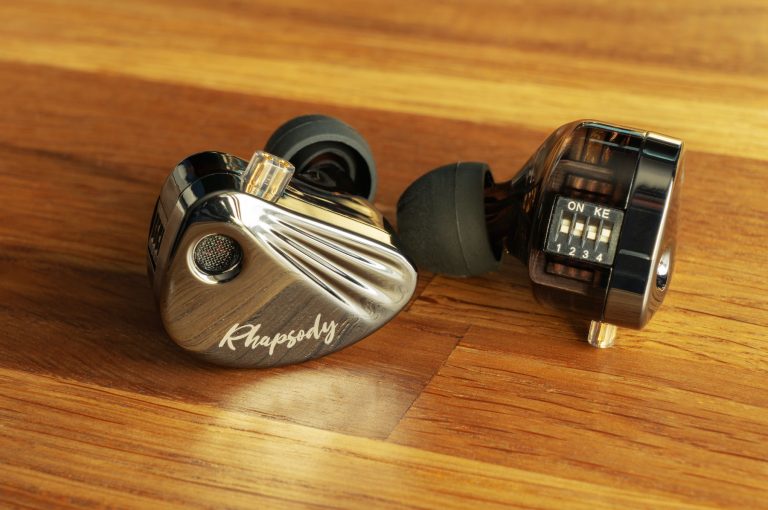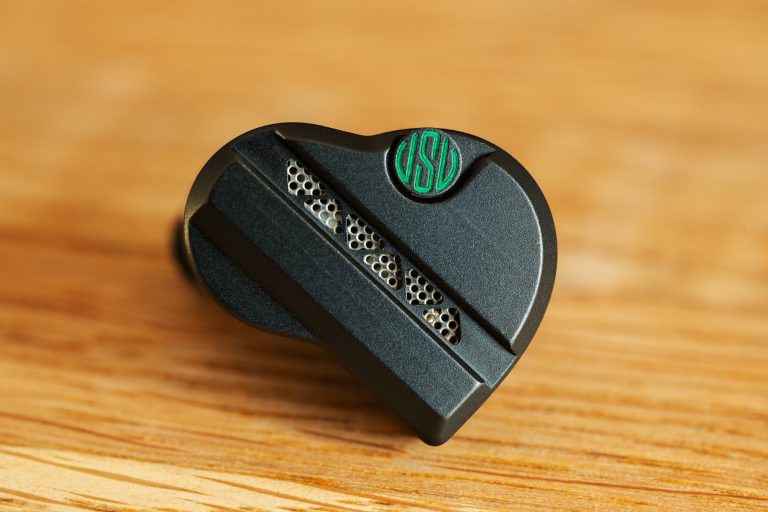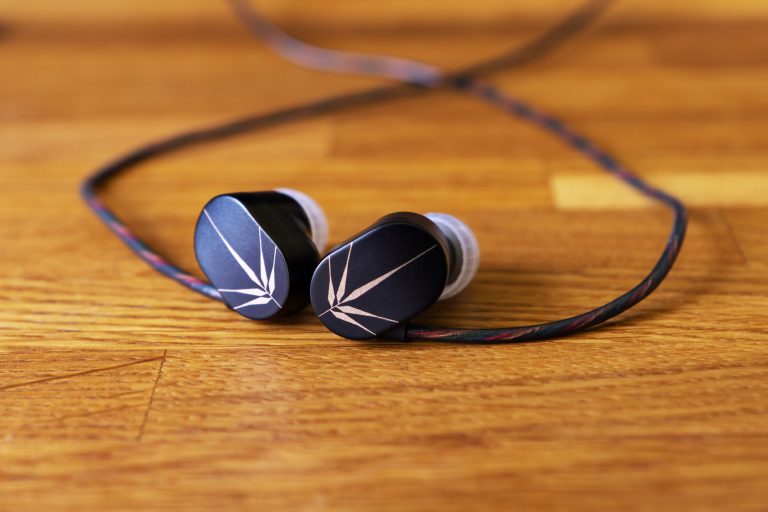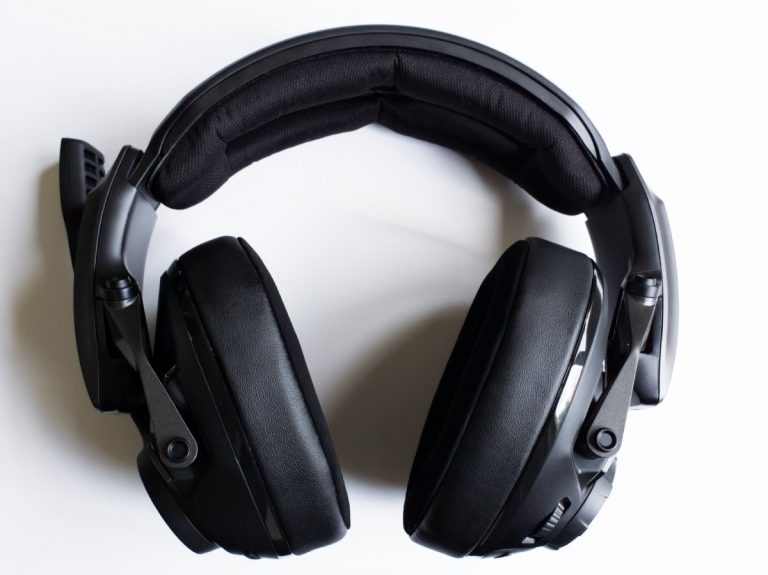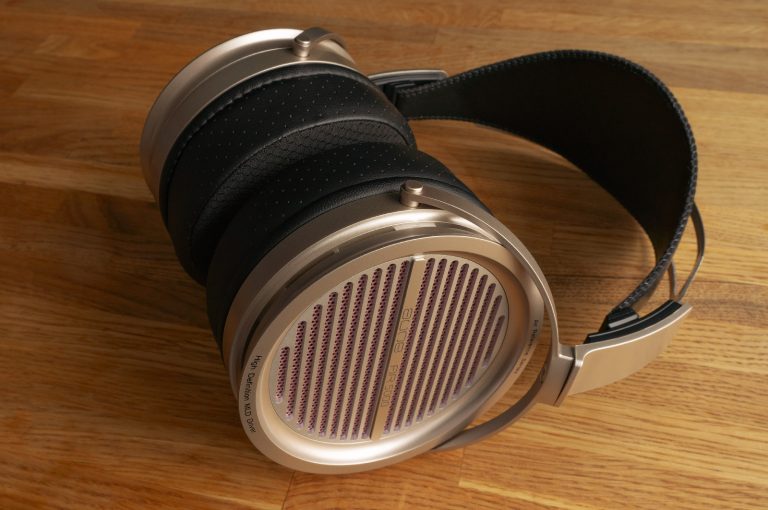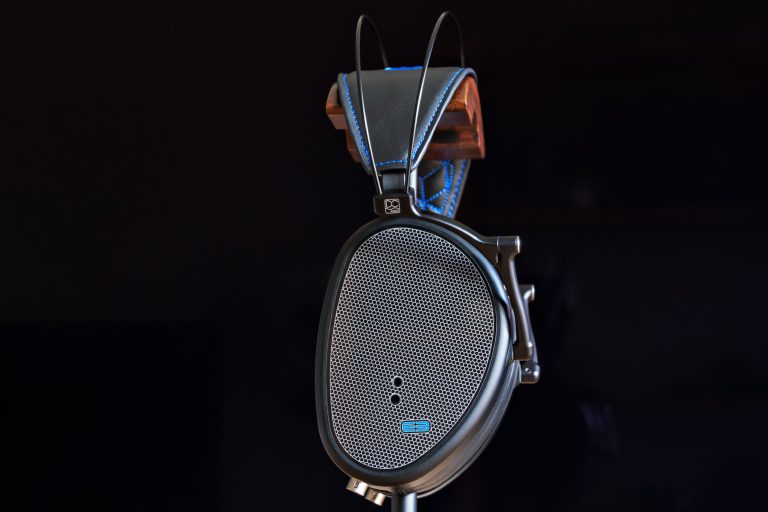About headphones measurements and a ‘Made in China’ rig
This is the fourth part of the material about headphones, curves, rigs, measurements and related researches. Here are the previous articles:
- About the sound in headphones and the Harman target response curve (Google translate)
- About headphones measurements and frequency response in particular
- About target curves, rigs, standards, neutrality and subjectivity of headphones sounding perception
There’s something I’d love to ask for before I begin with the matter.
I get a lot of messages from my followers and occasional readers, but for some reason people tend to send e-mails or private messages in social media, and not in the comment sections below my posts. To be honest, I don’t really care where the questions come from, but the situation actually affects the image my blog has for different hardware manufacturers. You know, sometimes I ask them to send me a pair of headphones for testing and review. The manufacturer naturally takes a look at my traffic – and the traffic is okay with them. But then they check out the comment section… and here goes nothing, since the comment number is somewhat LOW. No follower interaction, no headphones for review, right? So, if you’re really into what I do, please leave more comments. The more comments I get, the more likely I get interesting stuff for review. I review, you read, everyone happy. Let me remind you that the boizoff.com blog isn’t supported by any sponsors. Everything you can find here is done at my personal expense and the blog itself only exists because the topic appeals to me and you.
Let me remind you that the boizoff.com blog isn’t supported by any sponsors. Everything you can find here is done at my personal expense and the blog itself only exists because the topic appeals to me and you.
1. The rig. The equipment
1.1. The final assembly of the headphones measuring equipment
In the previous part of the article, I’ve outlined the following set required to measure headphones:
- two rubber ears: the left and the right ones;
- a metal plate to install those rubber ears and connect them to the auditory canal simulator;
- the auditory canal simulator itself;
- an adapter stand simplifying the physical placement of your headphones on the rig, and also helps to connect the rig to the sound card;
- BNC-to-3.5 jack cable;
- sound card with line/microphone input;
- in case of the in-ear headphones – a small adapter to install them on the rig. You can use the rubber ears, too, but it’s not very convenient.
Just in case: there’s more about the equipment in section 8.2. of the previous article, and the equipment itself was purchased here (but you just know that there are other Aliexpress stores with similar products). I have no idea on how much the quality of other manufacturers’ rigs differs from what I’ve got from the Sounds Good Store. And it’s quite obvious that you just can’t buy and try all, no – ALL the headphones at your place. Unfortunately, you’ll still need to take that kit with you to different stores and other sellers to test products. And yes, don’t forget another two indispensable items: a sound source to listen to and a case for convenient transportation of your equipment.
1.1.1. Sound source selection
This is what I expect from the sound sources:
- portability (that is, a rather small size);
- microphone input for you to not have a separate ‘proprietary’ sound card on hand;
- reliable main parameters, that is, good measurements;
- high output power at the headphones output;
- low intrinsic resistance at the headphones output;
- power via USB (without separate power adapters);
- preferably – phantom power.
And here’s my winner: the RODE AI-1.

This device meets all 7 requirements. Here are the related measurements. As for the power at the headphone output, it sports 390 mW with a resistance of 300 Ohms at THD <1%, and here some HD800S, Sundara and LCD-4 are ‘oh dear that’s LOUD’ at 1/3 turn of the volume knob already. Of course, the output power depends on the USB port power capacity. That’s why when using the AI-1 with a laptop, it’s better to keep the laptop wall-powered so that the USB power capacity doesn’t sag because of the energy-saving restrictions. The AI-1 is Windows-, Mac OS- and Linux-compatible, doesn’t require any drivers and can be connected to smartphones and tablets, too.
It’s just a very-very cool device.
With one downside, though: being designed for studio monitoring, the AI-1 is clearly not designed to be used with ultra-low-impedance headphones. That is, for example, my 12-Ohm Campfire Audio Andromeda gets really noisy. So unfortunately, the AI-1 won’t get you any reliable THD figures. Well, to be honest, if you want some genuine THD measurements, you’ll need some completely different equipment for some completely different money.
This is why I decided to connect the rig’s mic to the combined AI-1 input connector via the 6.3-to-3.5 jack adapter. Aaaand the mic didn’t work.
1.1.2. Mic operation: FAIL
It turned out that the rig’s mic requires a power supply of about 4 V and doesn’t work with the RODE AI-1 via a simple 6.3-to-3.5 adapter. So I tried some factory adapters with internal transformers like the RODE VXLR. And these didn’t work, either.
But then an engineer I know has crafted the following ingenious device:
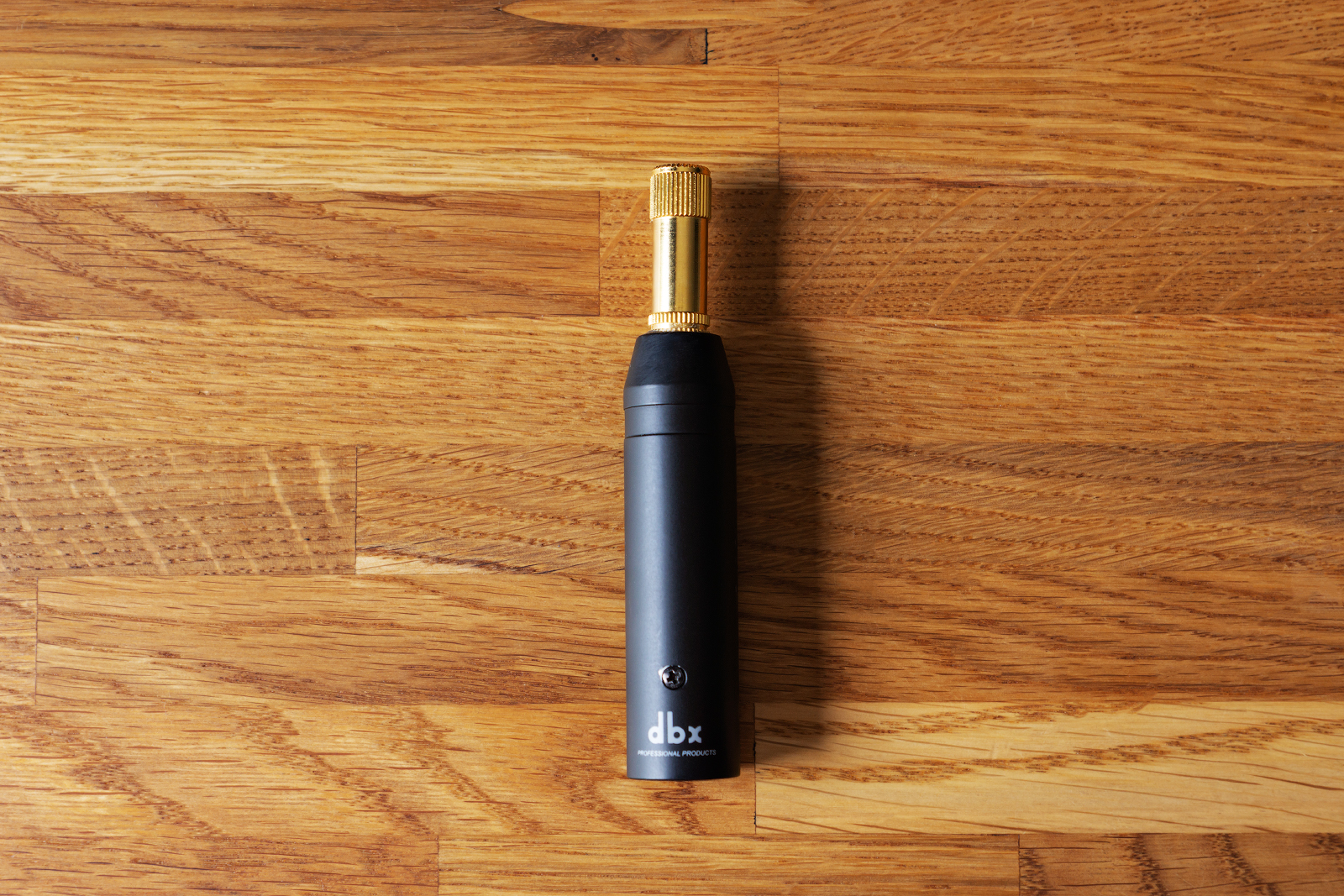
As you can see, it has the electrical part from a good DBX measuring microphone with the in-built transformer and an adapter for a 3.5-jack attached. And it worked! But the test measurements showed some stranger things by the sides of the frequency range (the blue line is for the mic with the proprietary soundcard, and the red one is for the one with the AI-1 + adapter):
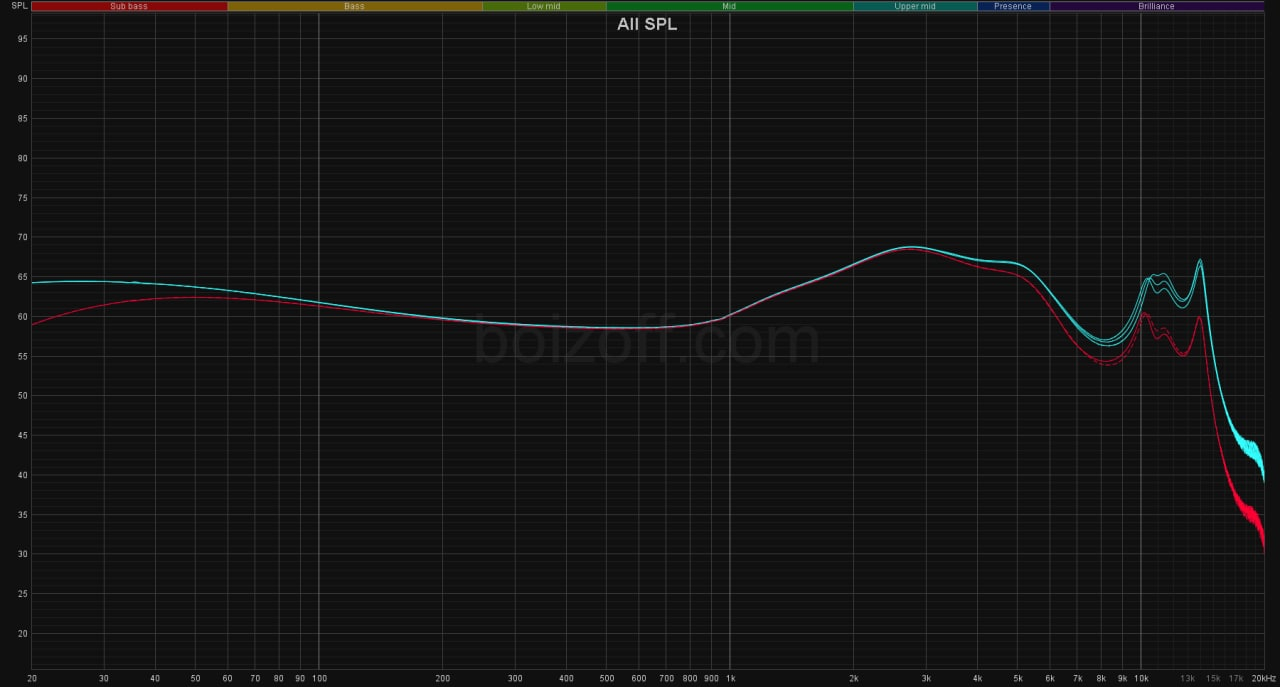
This is when I thought: maybe it’s about the adapter? To find the answer, I bought all kinds of adapters:

And boom! I was right: the adapter does the magic, and I was trying to use the incompatible one. The one which actually had never let me down before. Traitor. In other words, some adapters go well with a microphone, and some don’t. Reason unknown, case closed. And yes, they also have very different resistance values, but it doesn’t matter now.
The problem wasn’t solved, however. At least, not completely solved. Take a look at the comparative measurements from the same mic connected to the AI-1 via an adapter and to the ‘Made in China’ sound card directly:
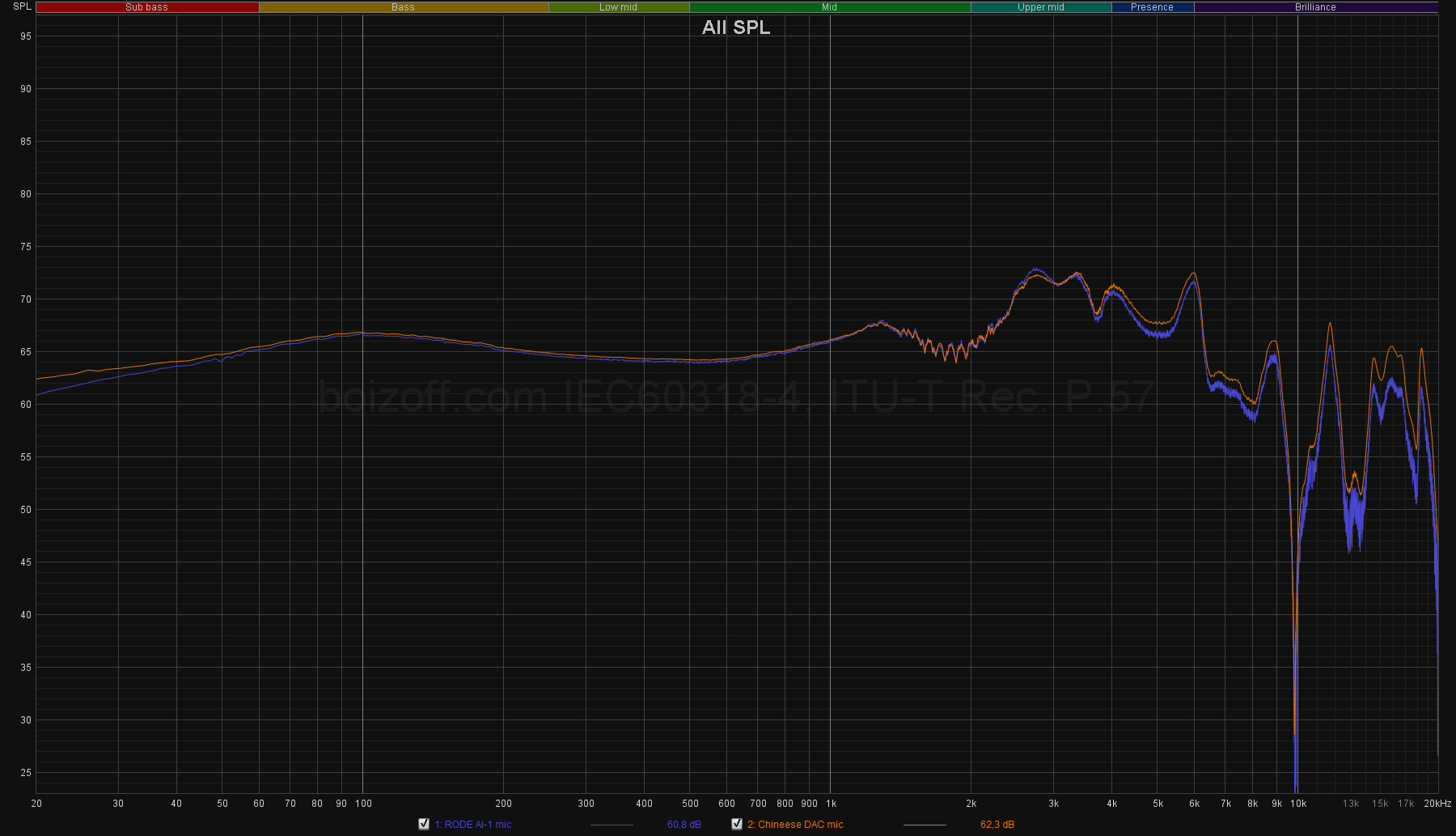
Why such a difference in frequency response and strange distortions after 4 kHz? I don’t know: this is where my technical knowledge is simply not enough. But if you have any guesses, shoot. Really.
The main thing is that after all these experiments, I decided to quit this dangerous game and just use the RODE AI-1 as a source, and connect the mic to the sound card in the old-fashioned way (like our ancestors probably did).
As for the low-impedance headphones… I thought it wouldn’t hurt to connect these to the same sound card, too. This sound card is more than enough for that.
1.1.3. The case
I love to feel comfortable when off for a grand tour (an audio store visit). But it might be an issue, especially when I have so much stuff and a laptop on top of that. What case would suit the request? I chose this option: it’s an 80*240*130 mm plastic case with foam inside. You’d want to plan ahead: once the foam is carved, it can’t be uncarved (wisdom of the day, right).
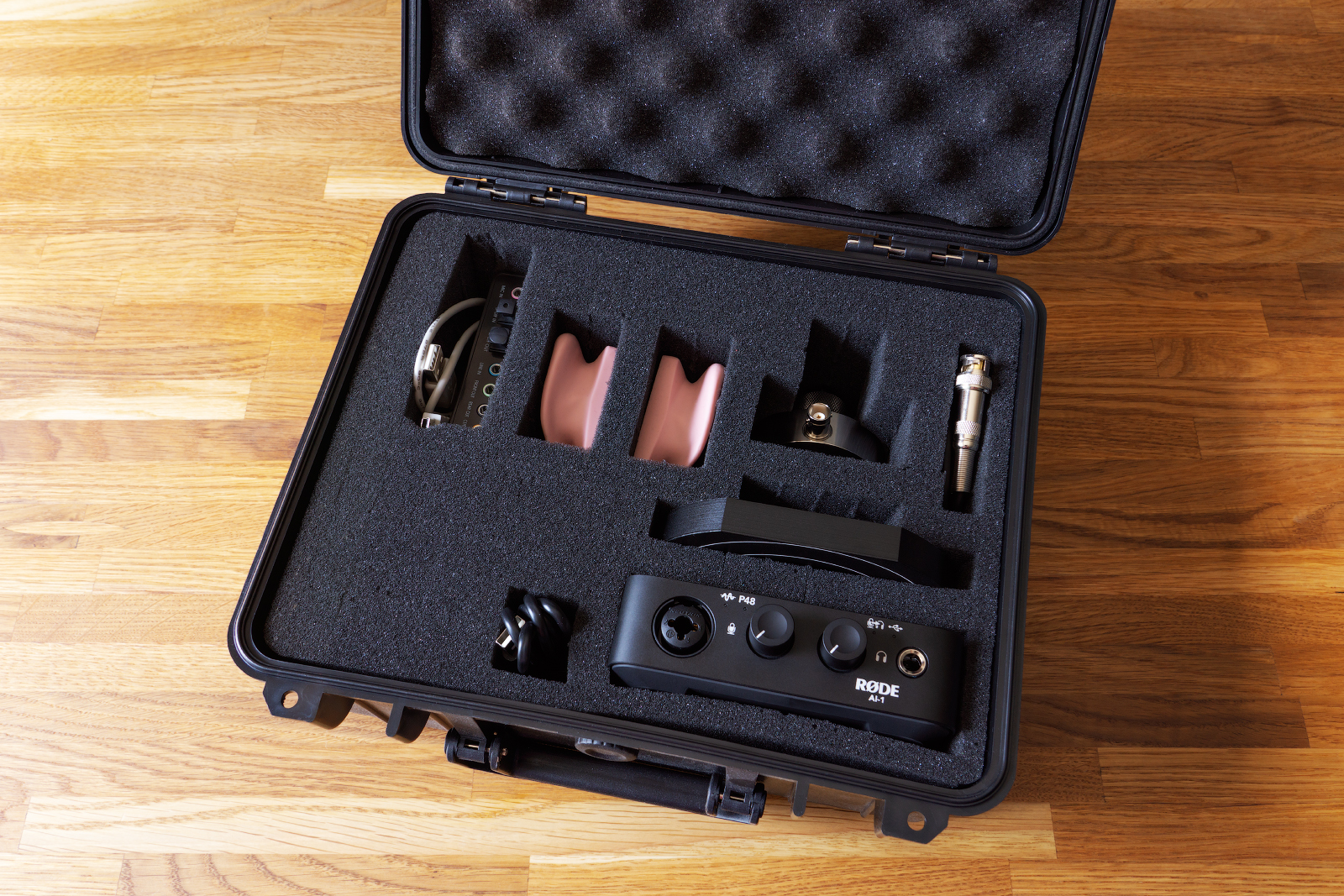
This is how my headphone measuring equipment looks now when in case. You just look at that 3D upper beauty so that the precious things don’t roll loose inside. The subway security didn’t ask any questions so far, but I still have some premade jokes for them.
2. The problems of measuring the over-ear headphones frequency response
First, a few words about why the frequency response measurements of the same headphone model on seemingly standard rigs can give discouragingly different results.
2.1. Difference between instances
Of all the factors affecting the measurements, the frequency response discrepancy between different instances of the same model may be the most significant. There are measurement graphs for two pairs of headphones of the same model below. These were measured on the same rig, with the same earpads, with the same pressure level, and by the same person (and it’s obviously me). The headphones positioning on the rig, as well as any possible shifts were all completely controlled and identical, which was ensured by using a laser pointer and a camera on a tripod.
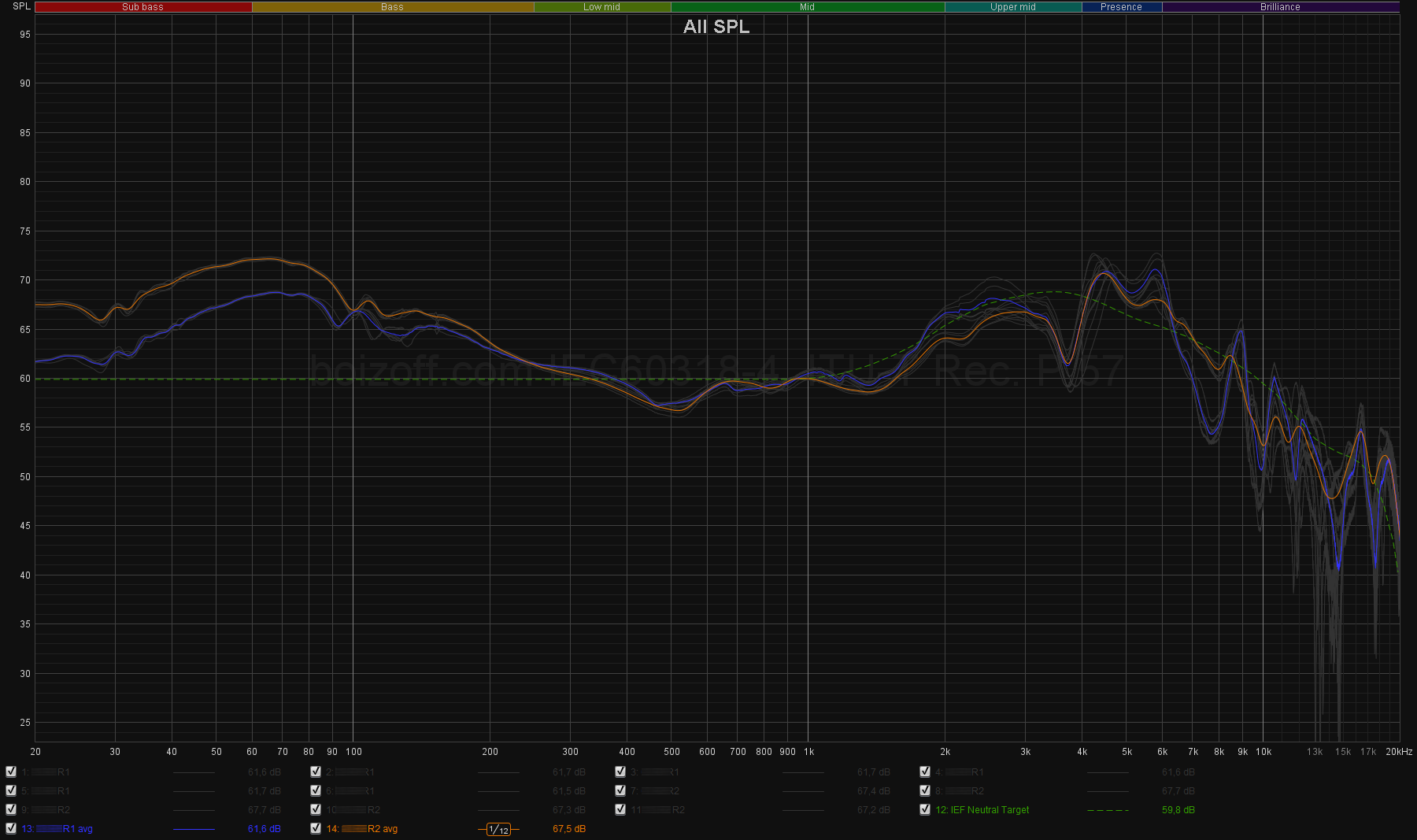
Looking at the left part of the graph, idiots would immediately go ‘IT’S THE PRESSURE LEVEL’, but no. First of all, it’s not a ‘PRESSURE’, and secondly, you just look at the 1–3 kHz, 6 kHz, 7.5 kHz, etc.
These headphones cost around $455, by the way.
I’ve covered model name just so no one gets over-excited about how shitty the model is. Because it’s not about the specific model: it’s a common trend, guys. Many believe that one manufacturer has better quality control, and another doesn’t give a damn about the quality, but the truth is that nobody really knows crap about their quality control. And you should never try to relate this aspect with the cost. I feel confident when stating this, because I’ve measured, for example, several copies of the same pretty expensive (more than $3,500, how do you like it?) model from a world-famous planar headphones manufacturer.
2.2. The pressure
The second most important thing is to determine the correct pressure level for your headphones. The earpads deterioration level matters, too. You need to understand the following.
- If an ‘average head’ is taken as a benchmark, the average interaural base (the average distance between the ears) is about 21 cm. At the same time, for recording stereo sound using the ORTF system, this value is 17 cm. Are there any race-related differences? Any correlation with the person’s age? Or sex? Alas, I couldn’t find any information. If you have any, please share.
- It’s completely unclear what pressure level is comfortable for the ‘average’ user. That is, even if we consider all the heads on Earth to be the same, there’s just zero data on how tight different people like it. We don’t even know what the manufacturer’s pressure benchmark was!
- The frequently used rig configuration, like mine, implies that the rig is placed on the edge of the table, one earpiece on a rubber ear, and the second one hung under the table. That is, the pressure is naturally ensured just by the weight of the headband and the second earpiece. Does this all ensure a 21 or 17 cm? It’s a pretty simple question. The savvy ones use a special spacer pulling the earpiece down to the desired distance, or craft a rigid frame 21 or 17 cm wide. But this doesn’t solve the problem from point 2, right?
- If the earpad is worn out, then it gets flat (at best) or its air permeability changes (worst case scenario). There may be cracks on the earpad leather, or the pseudo leather simply falls off from the surface in pieces. What do we do in the first case? Before the action begins, you’ll need to press the earpiece harder against the rig to reduce the volume of the front acoustic chamber affecting the sound. The second case won’t give you a chance of getting some reliable sound output measurements in the subbass and bass sections.
But even if the earpads are fresh – not crumpled and without holes, – even a small difference in pressure will affect the sound. For example, like this:

Or even like this:
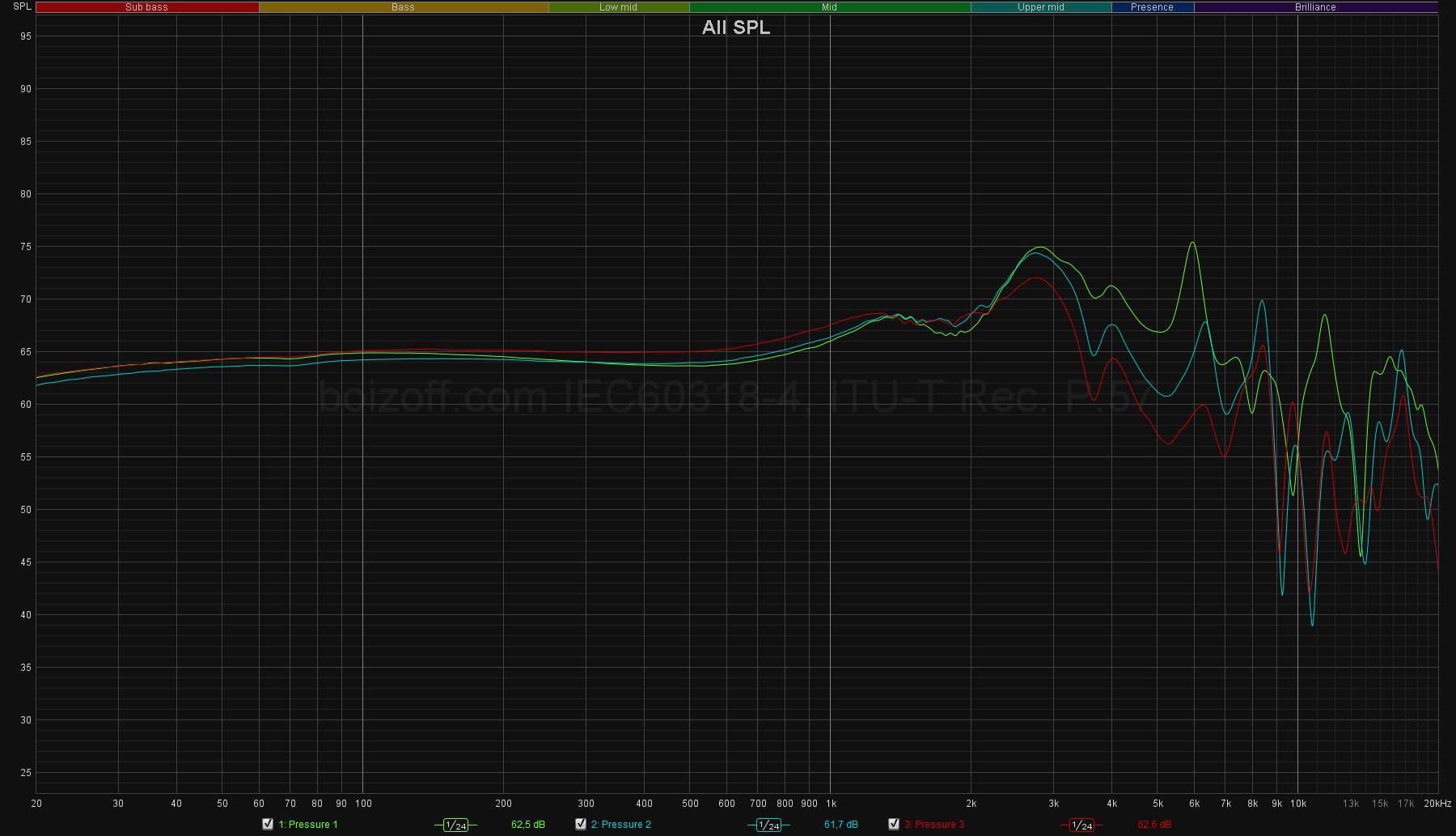
2.3. The shift
And not just a shift, but a shift with a turn, which also greatly affects the frequency response measurements, usually in higher-frequency range. Moreover, if the earpiece driver is installed in parallel to the head surface of the head (with reservations, of course), then the impact isn’t too big. But if the driver is placed at a small angle, as in Sennheiser HD800/S, Focal Utopia, Sony 1000xmX and even Logitech G933/935, then the sound will change very much at rotation. And here the situation is even worse than at an average interaural base, since nobody ever cared to research the average angle of the headphones people use.
In real conditions, it looks something like this:
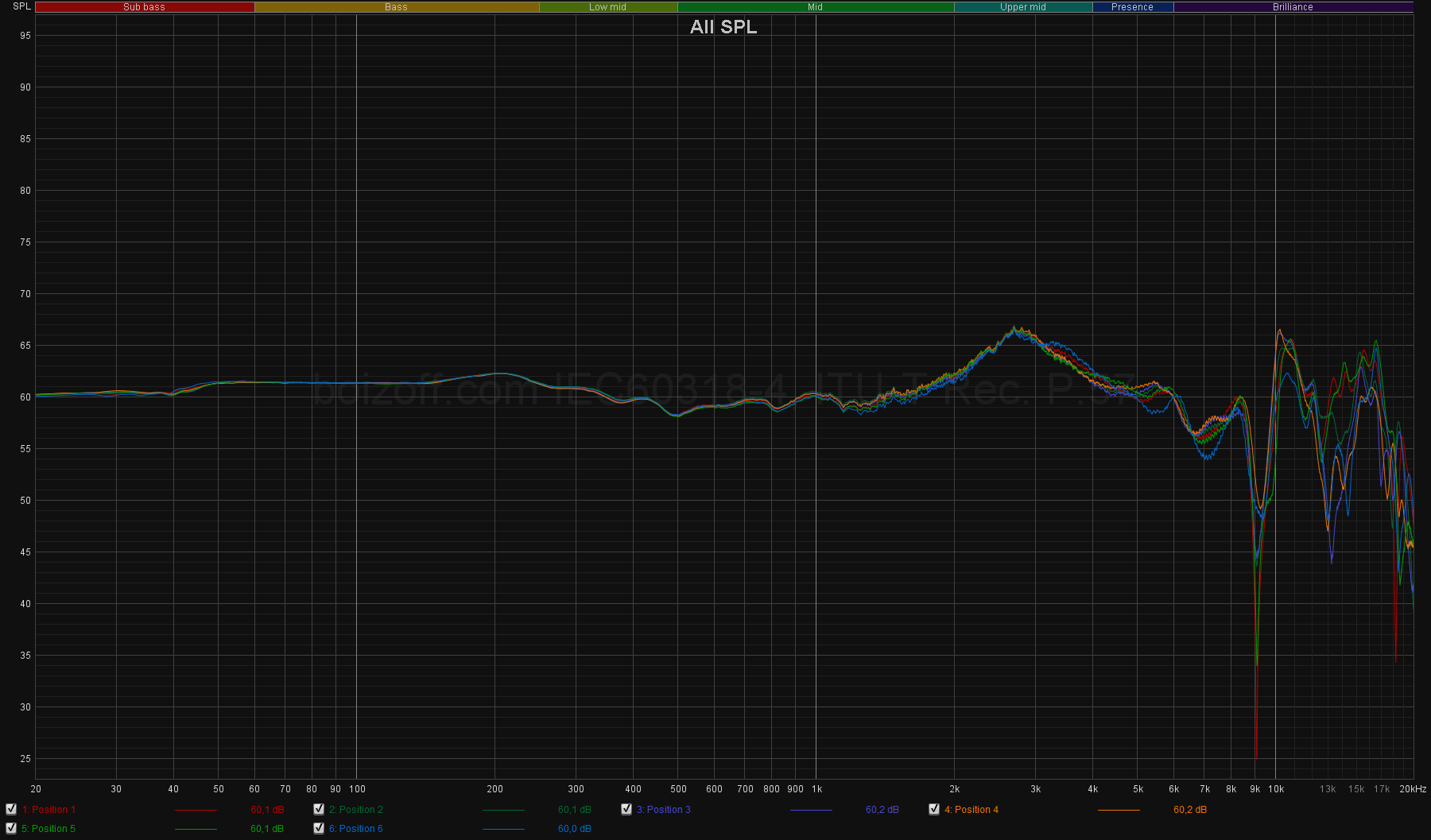
3. The limitations and the accuracy of measurements strike back
3.1. The rig limitations
I’ll let myself remind you that the IEC60318-4 standard itself and the complying inner ear simulator are limited in measurements by the following parameters.
- Frequency range: from 100 to 10 kHz
- Measurement error: from ± 0.6 dB to ±2.2 dB
3.2. The real difference between the ears
This calls for some research. We don’t know much about, uhm, human ears, but there’s still, say, more than a hundred of studies, so I’ll probably write a separate post about these. Now let’s check out some of the works.
3.2.1. ‘Transfer characteristics of headphones measured on human ears’
(1995, link).
The study was on 40 persons (22 men, 18 women) with definitely normal hearing and the absence of any middle ear dysfunction. 13 over-ear headphones models were used for the study. The measurements were made three times in each participant and each headphones model on different days of the week.
The measurements were read at the entrance to the ear canal with the open ear canal.
Here’s one of the conclusions of this study (not the main, though):

PTF is a function of several variables, including the features of a particular auditory canal of a particular research subject.
Simply put, the above conclusion means this: up to 2 kHz, the auditory canals of different persons affect the sound more or less equally. In the 2–7 kHz section, the difference is already quite clear. And at 7 kHz and above the impact is very significant.
And this is how the measurement graphs for 13 headphones models in 40 different participants look like. In other words, each diagram shows 40 measurement graphs for the same headphones obtained in 40 different persons:
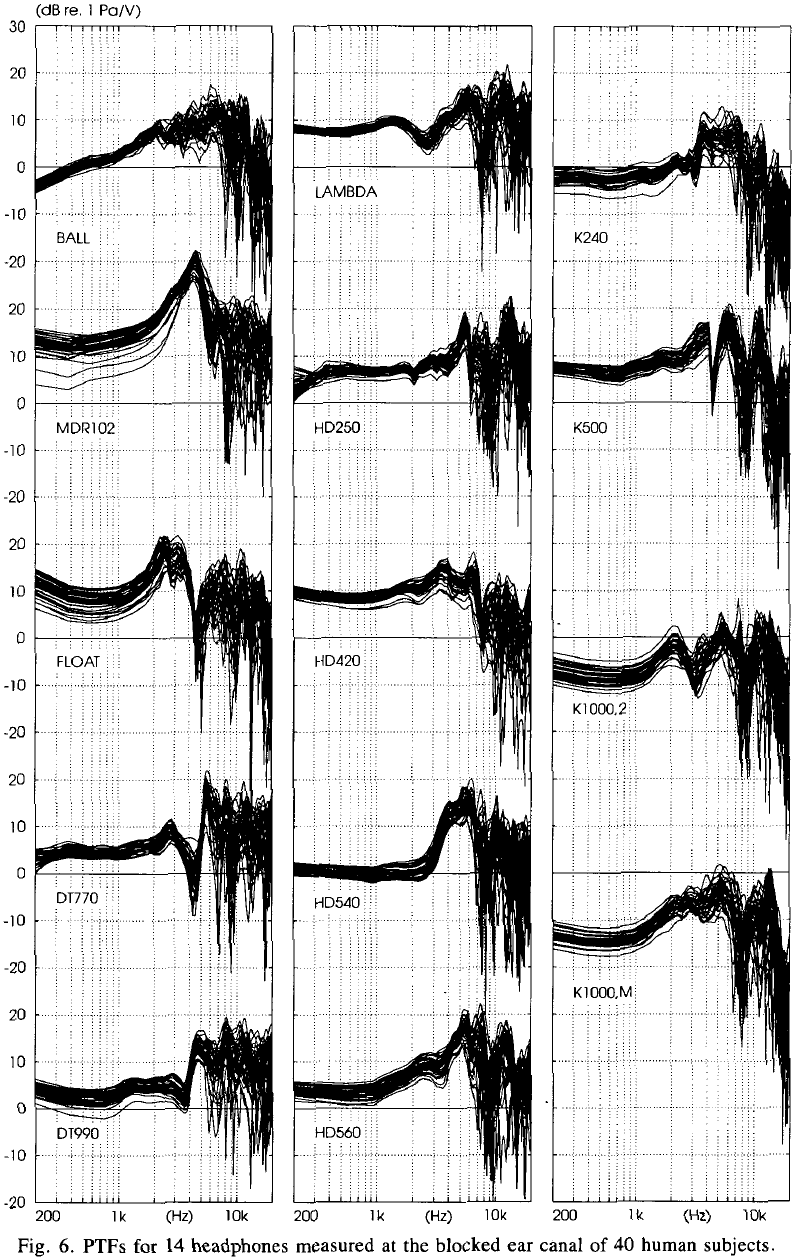
3.2.2. ‘Perceptual evaluation of individual headphone compensation in binaural synthesis based on non-individual recordings’
(2012, link).
2 women, 23 men, 10 measurements of HpTF (Headphone Transfer Function) for each participant at the entrance to the closed auditory canal. The same headphones instance, which is the STAX SR 202.
The measurements were read at the entrance to the ear canal with the ear canal closed.
Here’s one of the results:
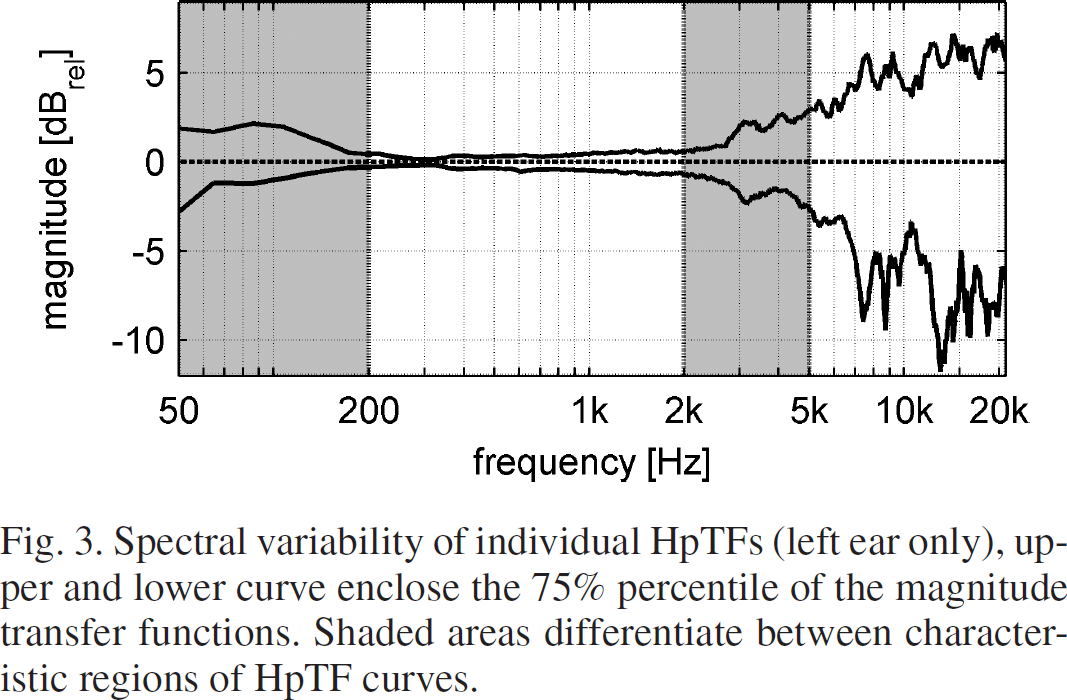
Quote:
‘Below 200 Hz (region I), differences of ±3 dB can primarily be assigned to leakage effects. Up to 2 kHz (region II), differences are smaller than 1 dB. Above 2 kHz and up to 5 kHz (region III), deviations quickly increase to ±3 dB. Above 5 kHz (region IV), the region of narrow pinna notches begins. Deviations in that range are distributed asymmetrically between approx. +7 and −11 dB, respectively.’
3.2.3. ‘Wideband impedance measurement in the human ear canal’
(2018, link).
This study conducted on 32 (19 women, 13 men) adult subjects with normal hearing teaches us the following.
There’s quite a significant difference in audibility in the higher-frequency range in different age groups:

There’s a measurable difference in audibility in the higher-frequency range in men and women:
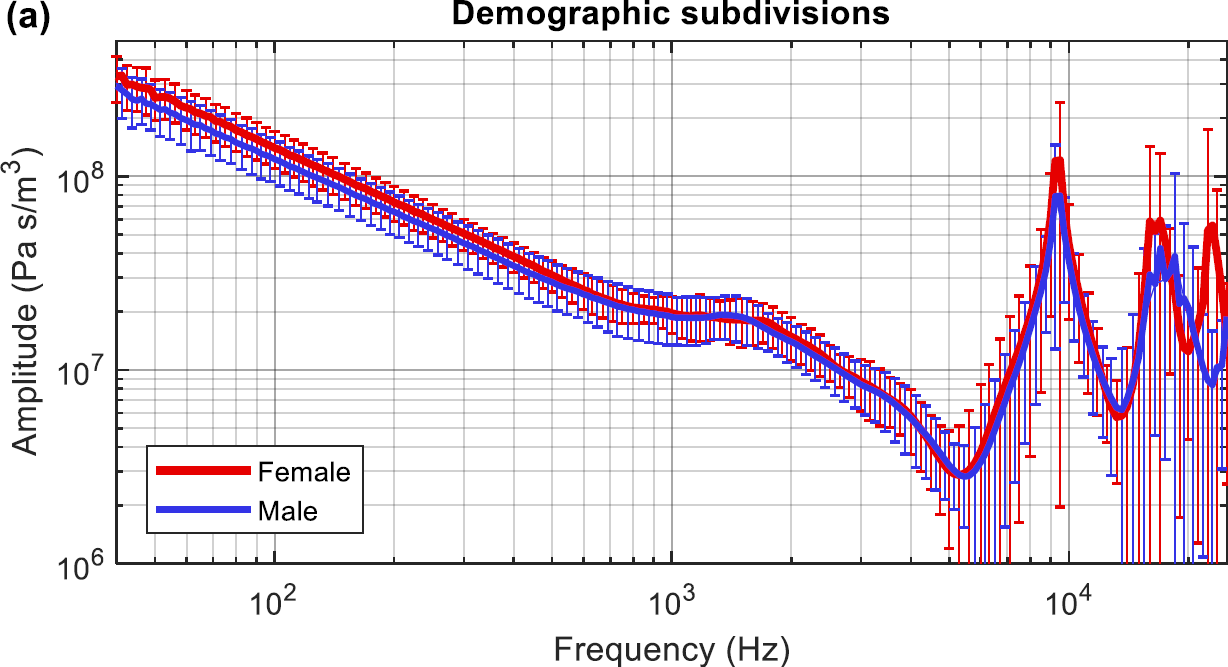
In the 1–5 kHz range, the auditory canal simulator complying with the IEC60318-4 standard generally shows wrong results (by about 3 dB down in average):
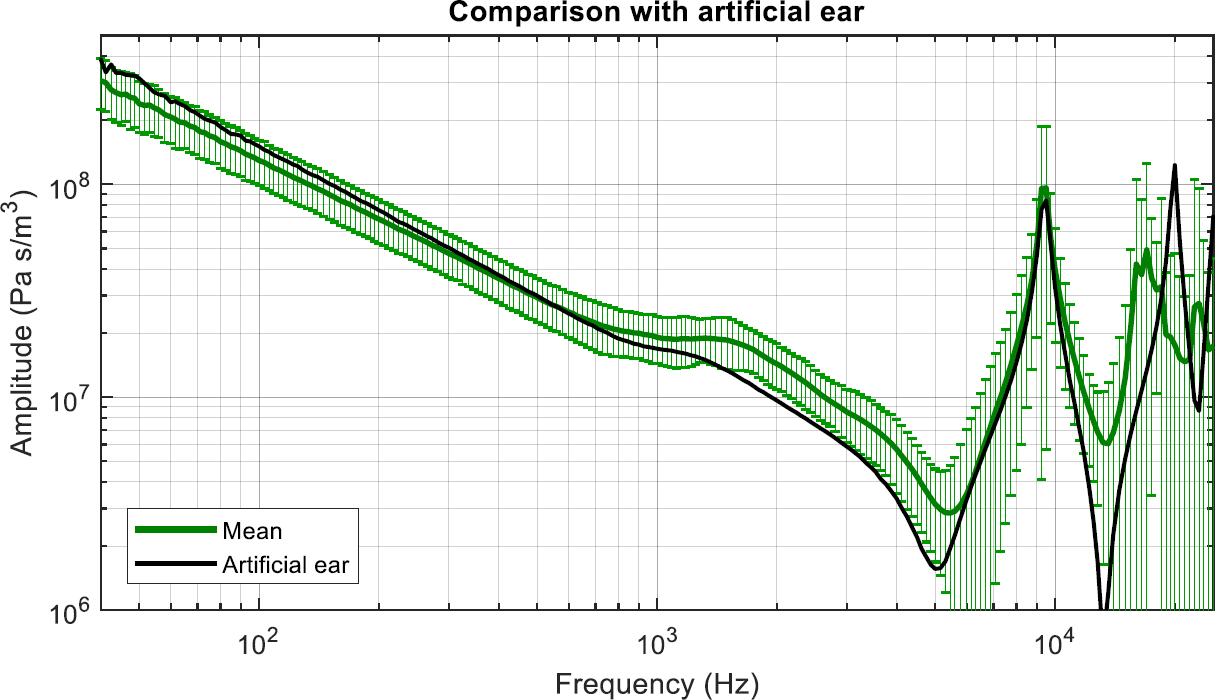
3.3. Summary (the rig limitations and the measurement accuracy)
Let’s summarize this section.
- Human ears aren’t the same, and you can actually measure that difference. Everything’s heard more or less (I mean it: more or less) alike up to 7 kHz, but then – welcome to hell. It would be extremely interesting to see the results of studies with larger sample groups, with a percentage distribution of deviations, some dependency analysis and all. But I couldn’t find any. Should I take it as ‘these don’t exist’?
- The simulation-model approach using ‘an average rubber ear with an average auditory canal’ has its limitations: the headphones frequency response graph won’t tell you how exactly YOU personally would perceive the headphones sound delivery.
- The IEC60318-4 standard, for example, actually can tell something about the headphones frequency response, but only in the 100 to 10000 Hz range with an error from ± 0.6 dB to ± 2.2 dB, and in the 1 to 5 kHz range, the auditory canal simulator itself has a -3 dB error.
- The Chinese copies of GRAS rigs weren’t assessed for compliance with their ‘validated’ prototypes. Therefore – let’s be downright honest, – the topic of how much they comply with the IEC60318-4 standard is rather a terra incognita for us. Well, we still can analyze the degree of compliance. You just keep reading.
Oh the crude reality of evidence-based audiophilia!
4. General recommendations for over-ear headphones measuring
I’d love to give a couple of tips to those who, for whatever reason, decide to do such an ungrateful task as headphones measuring.
1. Take headphones with new/lightly used earpads. Well, if you still want to try it with really battered earpads, better make a comment about it or include this fact in the name of your measurements file. It’s really easy to forget.
2. You absolutely should pick headphones with the manufacturer-provided earpads, because the earpad materials, perforation and thickness affect the sound RADICALLY.
3. Monitor the pressure level. Ideally, get yourself a full-fledged rig with a frame – preferably with a configurable distance between the ‘ears’.
Here’s what an acceptable rig can look like:
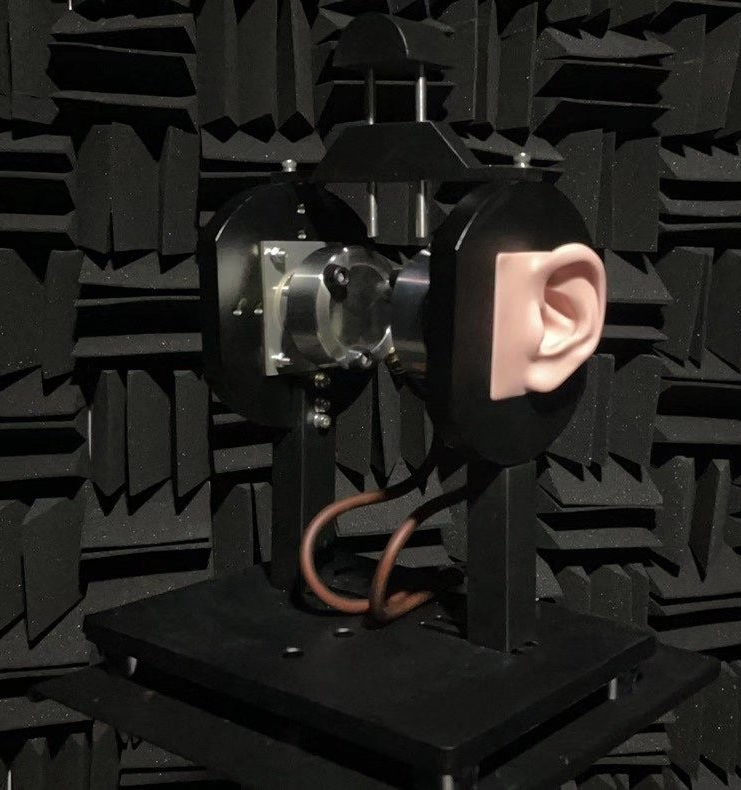
And this is the one to avoid using:
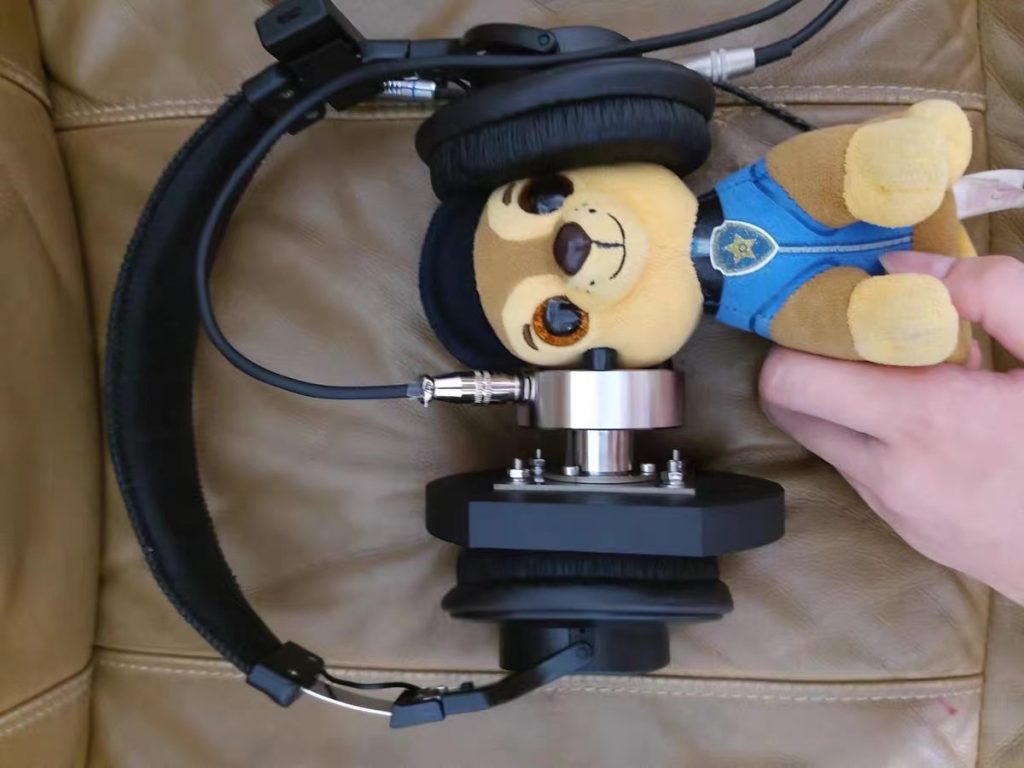
4. Take many measurements. Like, 10 measurements with small turns and shifts, then identify and remove any obvious deviations, and average the remaining results. No one’s come up with anything smarter. At least, so far.
5. If possible, measure several instances of headphones of the same model. Why so? Read the above sections.
And even if you did everything right, very carefully and thoughtfully, took some span-new earpads, allowed exactly 21 cm inter-ear distance, averaged your measurements even from several headphones instances… The result will still reflect only the nature of the specific headphones sound delivery (and not the sound as perceived by the user) and only in the 100 to 10 kHz range with an error of up to ± 2 dB (reserved to the rig itself). And you personally, your friend, your mom will hear something specific, unique with a 0 to +7 /-11 dB difference depending on the frequency. And what will your mom hear above the 7 kHz, is a complete mystery. Oh, and don’t forget about such factors as sex (biological one!), age and sound volume, too.
And this is provided that the ‘Made in China’ auditory canal simulator 100% complies with the IEC60318-4, and the rubber ear complies with the ITU–T REC.57 (I’ll elaborate this below).
Oh materialism, thou art a heartless bitch.
So, does it mean that measuring headphones is kind of pointless?
5. Why do we need headphones measurements?
The headphones measurements made using standardized rigs can’t be just useful or useless. These measurements are just a tool. Like, say, a shovel. Is a shovel useful? Yep – when digging holes or forcing your way through a crowd of zombies. But when trying to start a fire, you’d need something else. Well, who would actually analyze the shovel’s overall practicability, right?
So, when could you use the headphones measurements performed on standardized rigs?
To determine a degree of compliance of the headphones frequency response with some standardized (and defined only for specific rig standards) curves, to compare different headphones, to get some idea on how the listener perceives the headphones sound delivery. And an obviously right thing to note: despite all the limitations and errors, the measurements remain a much more reliable way of describing sound than some inaccurate and loosely interpreted statements of individuals like reviewers. You know why? Because the actual human auditory system and the brain of a particular individual make the sound perception so much more random, subjective than even an imperfect rig – just because of that gazillions of different factors and individual features.
When should you avoid using the headphones measurements performed on standardized rigs?
To answer all sorts of subjective questions like ‘will I like these headphones?’, ‘do they deliver a decent bass?’, ‘are they any good?’, ‘do they go well with classic/metal/electronic music?’. Any person (other than yourself) having actual answers to these questions, should burn in hell.
And then how do you choose headphones that will work for you personally?
Quick guide.
- Construct a Head Related Transfer Function (HRTF) of your own ears.
- Find out which specific Fletcher-Manson curve corresponds to the sound pressure at which you usually listen to your music.
- Perform a series of experiments (just like they did at Harman) to find out which frequency ratio is the most balanced/’tasty’/pleasant for you.
- Take the first three graphs and transform them into your personal target curve.
- Select the headphones model with measurements looking the closest to your target curve.
Sounds a little bit like building a black hole simulator, right? No one gets a free ride to the audiophilia Eden.
Okay, the second option is to go and try different headphone models. If you can, of course.
6. Calculation of the rig deviation when measuring over-ear headphones
The last important topic for today is to what extent does the Chinese rig meet the standards, and what will happen if we add the GRAS 43AG measurements to the equation.
It just so happened that I don’t have my GRAS 43AG at hand (not that I ever owned one, thank you price setters), so I had to use the only available method – to compare measurements obtained from different instances of the same model headphones made with GRAS 43AG (from crinacle.com) and my perky rig. And since every problem described in paragraph 2 is here, I’ve processed oh so many measurements. To be precise, the measurements of 37 different models of headphones.
The result? Encouraging. My rig isn’t exactly accurate, but not every measurement is a lie, and when it is inaccurate – the error isn’t something of a catastrophe.
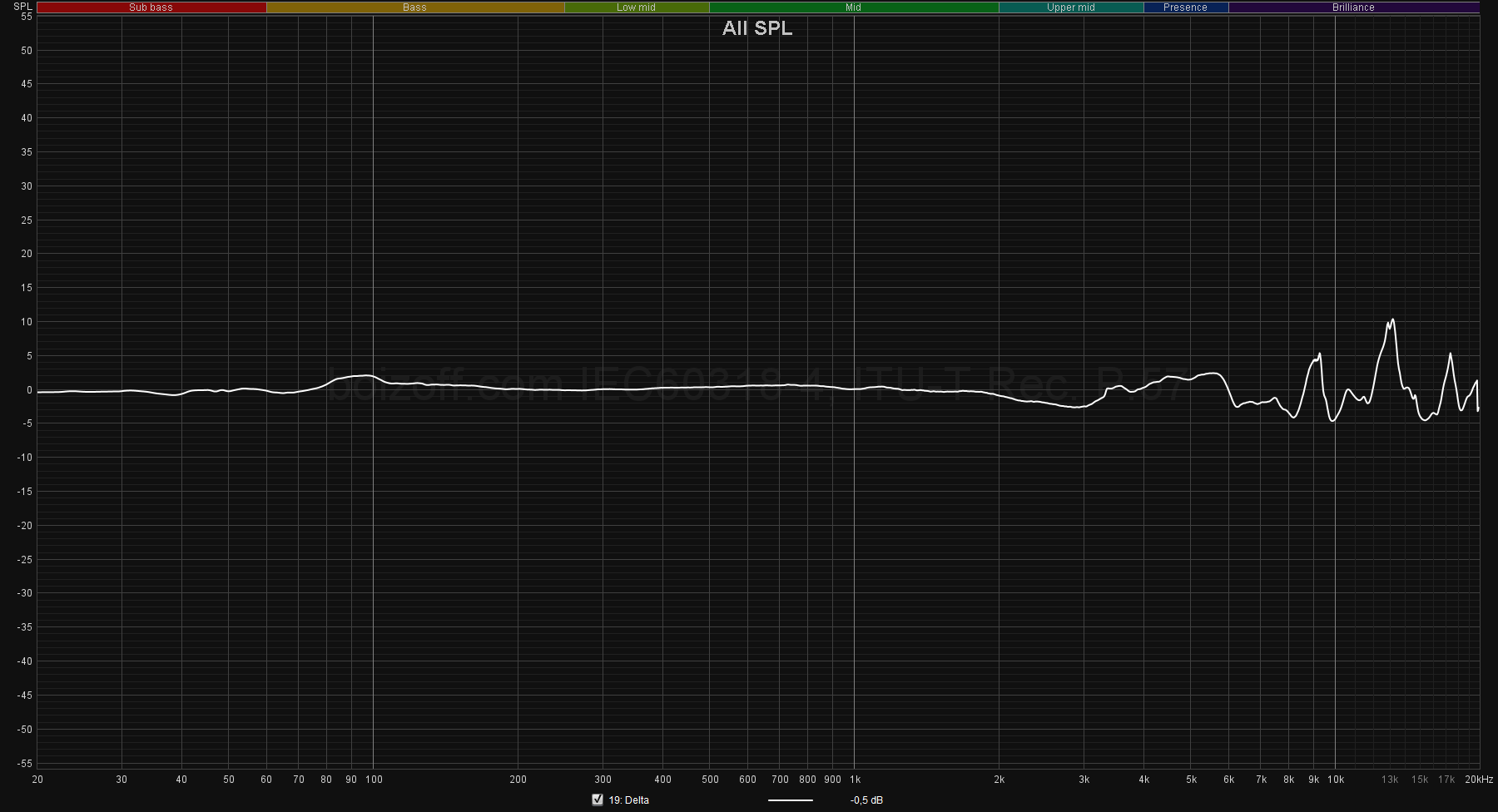
This is how the deviation curve of my particular rig looks like. Given the fact that we don’t really give a flying fuck about the values beyond 10 kHz, the remaining part of 100 Hz–10 kHz section looks surprisingly good (except for sections at about 3 kHz and at 5–6 kHz).
That is, the next thing to do is to invert the curve vertically and use it as a correction aid in addition to the manufacturer’s figures.
Well, with this resulting curve and taking into account the differences in instances, earpads and measurers (measurement performers? measurement experts? who are we?!), let’s now compare my results with the crinacle.com ones.
The AKG K610 Pro:

The Focal Clear MG:
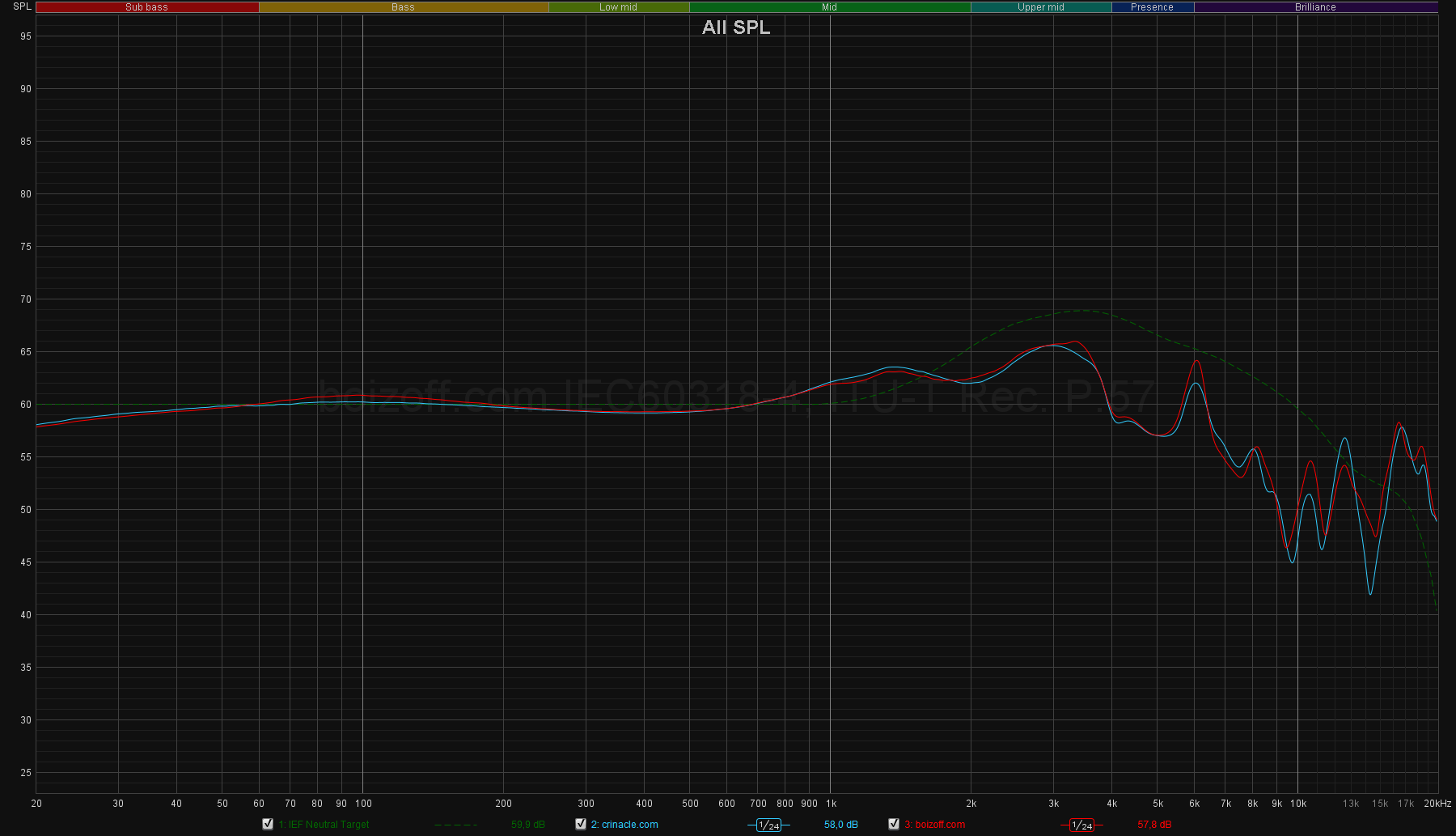
The Fostex TH610 (left earpiece only):
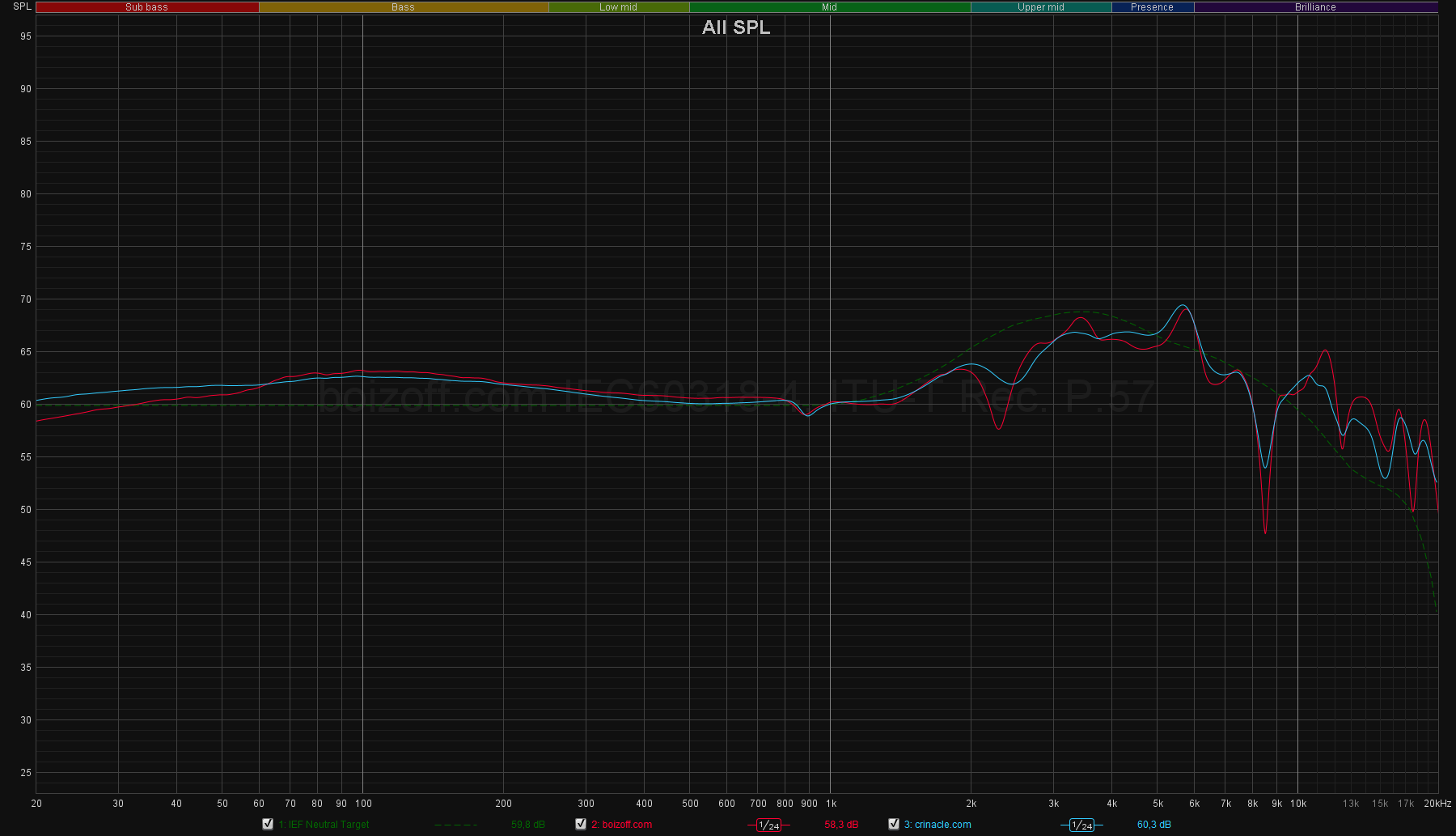
The Meze Elite:

The Focal Utopia:
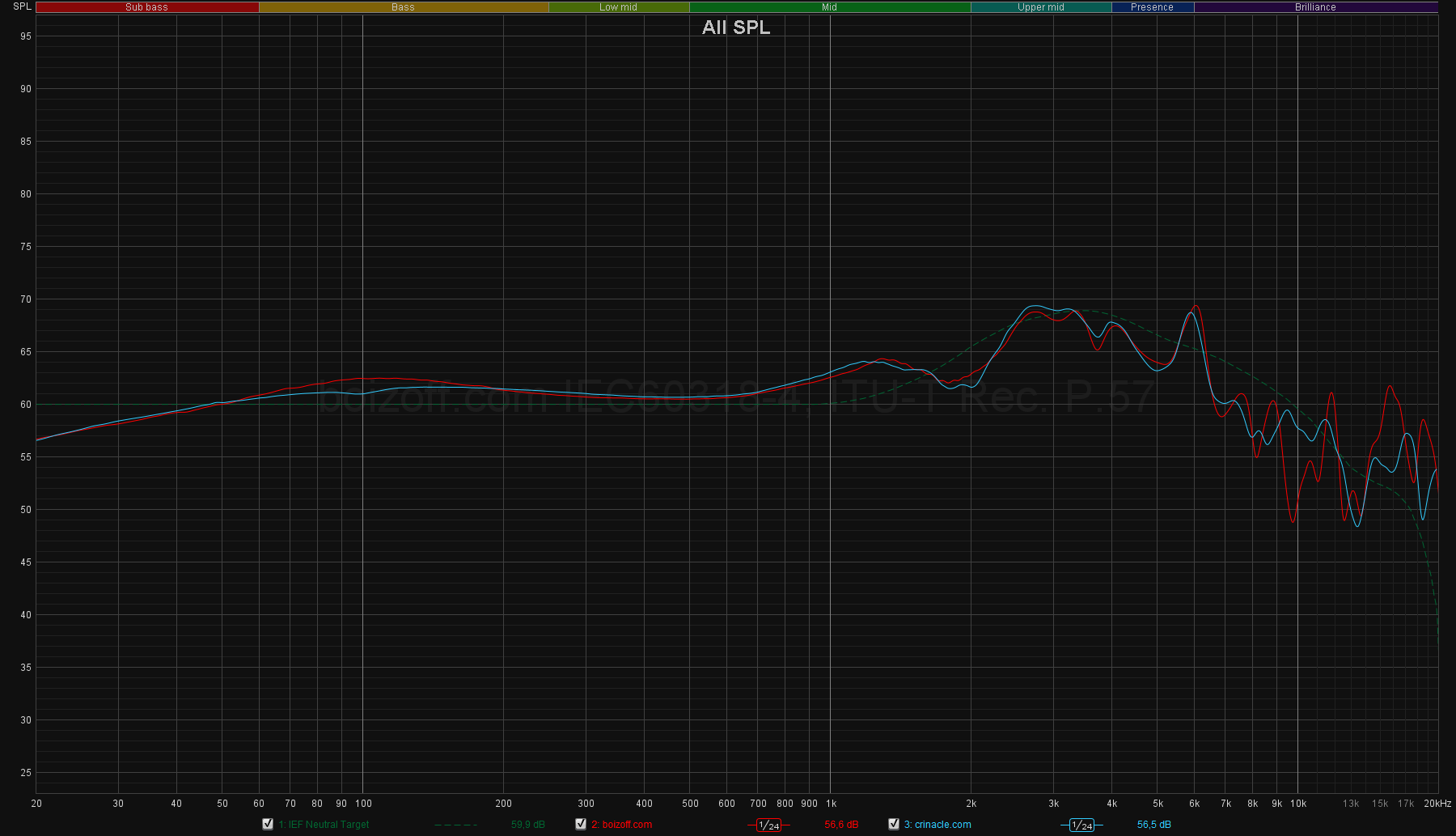
Please keep in mind that the crinacle.com measurements can contain errors, too – everyone’s deviations turn out to be about the same. Anyways, I’m going to try and refine the correction curve as the time goes. It would be great, of course, to fiddle around with the real GRAS 43AG, take the very same headphones, and compare measurements from two rigs. But no GRAS rig is here, at least for now.
That’s pretty much all I had to tell you.

